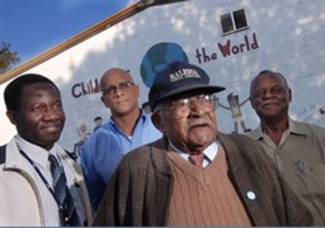Collection Name
About
A living tribute
Originally published October 03, 2007
By Nancy Hernandez
News-Post Staff
Nearly a year ago, Lord Nickens stood in front of the William O. Lee Memorial Bridge and called on Frederick to recognize the contributions of black residents.
"I want to see many, many blacks honored on something other than a bridge," he said.
At the time, he didn't know he would become the first black resident to have a street named after him.
On Tuesday, Bernard Brown, chairman of the City of Frederick's Housing Authority's Board of Commissioners, said the city has renamed alleys through the years, but Lord Nickens Street will be the first road to bear a black resident's name from its inception.
"Of all the people to have the first street named after him, he would be my choice," Brown said.
Preparation to build Lord Nickens Street are expected to begin this month, said Kevin Lollar, development director for the Housing Authority. The street will connect Bentz and Market streets where the Roger Brooke Taney and John Hanson apartment complexes once stood.
A new housing development, HOPE VI, will take the place of those homes. The site is one of several HOPE VI projects. It will include 55 houses, 12 affordable rental units and 27 public housing units.
Lee's name will also grace a community center at the site, as it did in the Taney-Hanson complex. Lee was an unofficial historian for the black community in Frederick.
Besides Lord Nickens Street, four of five other roads to be built in the neighborhood will bear the names of deceased black residents: Walker Lane, Brunner Place, Dixon Way and Daley Lane. A fifth street will be named for Emma Smith, a white woman who founded Frederick Memorial Hospital.
Nickens, who served as president of the Frederick branch of the National Association for the Advancement of Colored People for more than 20 years, said he tried many times to get Frederick to name a street after a black resident. He is pleased to have been selected for the honor and hopes it will lead teens and children to learn more about the struggles and accomplishments of their ancestors.
Lollar submitted the names to the city for approval. He wanted to pay tribute to former black residents after hearing from Brown about the history of the Laboring Sons Memorial Ground.
"It's one of those stories that brings tears to your eyes," Lollar said.
The memorial site, on Chapel Alley between Fifth and Sixth streets, was a black cemetery when it was donated to Frederick, Brown said.
Laboring Sons Cemetery was established in 1837 to provide a burial ground for black residents, according to the city. It remained a cemetery until 1948, when a playground was built. After lobbying efforts by descendants of those buried there, the city voted in 2000 to remove all playground equipment and make the park a memorial ground.
Among those who helped lead those efforts were descendants of Ulysses Daley, so his name was chosen to be honored with a street, Brown said.
Brown, who also serves as exalted ruler of the Mountain City Lodge of the Improved Benevolent Protective Order of Elks of the World, consulted with Elks members to recommend names to Lollar.
"We came up with names of people who played significant roles," Brown said.
Brown believes it's fitting the men are being honored with streets in a section of town where many black residents have lived, worked and volunteered.
John Brunner was the first black supervisor of education for black residents in the late 1920s. He lived between fifth and sixth streets, not too far from the street that will bear his name.
Albert Dixon was a funeral director for many years at Etchison Funeral Home, helping families as they coped with the loss of loved ones.
William Walker lived on Chapel Alley and was an active member of the Elks for 60 years. Brown remembers him as a wise man, but one who didn't offer his opinion unless asked. He never spoke a harsh word against other people and was always willing to help in the community.
"He reminded me of an old style minister," Brown said of the man who was rarely seen without a white shirt and tie.
Guy Djoken, president of Frederick branch of the NAACP, said Lord Nickens Street will present opportunities to teach young people about Nickens and his tireless work to earn equal rights for all.
"He put his life on the line many times," Djoken said. "He never gave up. This is the community as a whole saying thank you."
Photograph: Lord Nickens, center, will soon have a street named after him. With Nickens, from left, are Guy Djoken, president of the NAACP Frederick branch, Kevin Lollar, director of development for Frederick’s Housing Authority; and Bernard Brown, chairman of the board of commissioners for Frederick’s Housing Authority.
Reprinted with permission of the Frederick News-Post and Randall Family, LCC as published on October 3, 2007 at FrederickPost.com
